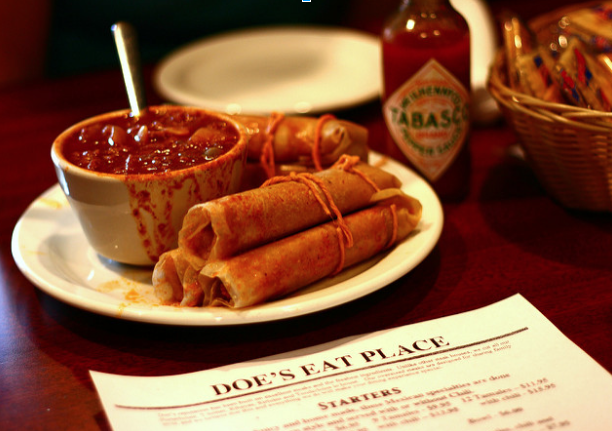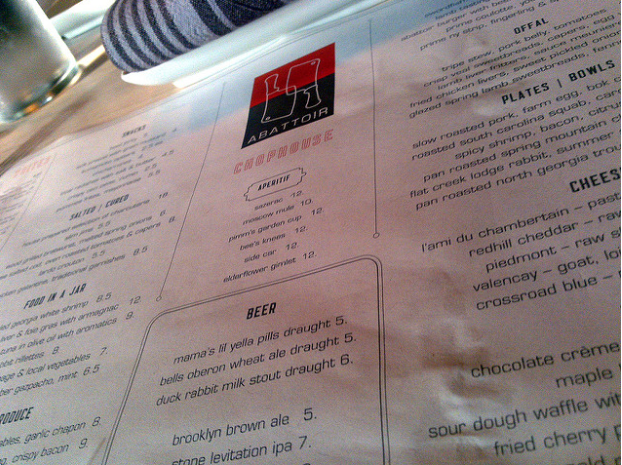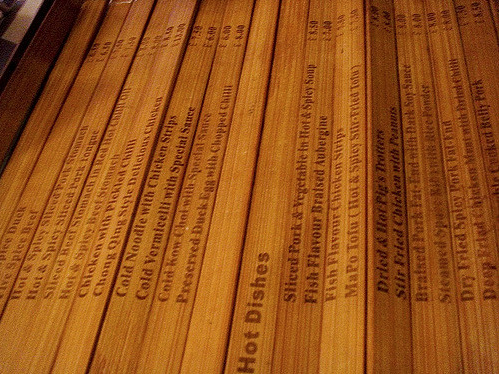 (Source: Flickr)
(Source: Flickr)
What’s it like to read your restaurant’s menu? Is it beautiful, but printed in a font that’s hard to read? Are the descriptions so long and flowery that customers get bored, or are they so short and cryptic that customers can’t be sure what they’re actually ordering?
An unclear, poorly laid-out restaurant menu could be keeping your restaurant from reaching its full earning potential and can be a factor in customers choosing not to return to your restaurant. By making simple changes to the menu itself (no changes needed for the actual offerings!) you have the potential to streamline the ordering process and improve sales. Here are 8 easy ways to make your menu more effective:
- Give your menu items interesting titles. Which item seems more enticing: “Red Seafood Soup” or “San Francisco-style Cioppino”? Chances are, you chose the latter. Think of the menu as the first chance that you have to “sell” your food; make it appetizing from the get-go, by making its title an enticing one.
Think of what makes the dish interesting and unique, and then try to reflect that in the name. Beware of being too abstract with your names, though; if the title doesn’t actually give an indication of what the food actually is, you should be sure to pair it with a clear description.
 (Source: Flickr)
(Source: Flickr)
- Offer artful yet concise descriptions. Creating great menu descriptions is an exercise in balance. You want your menu descriptions to sound enticing, but you don’t want the menu to read like a book. In general, you want to keep your descriptions to 1-2 sentences that concise and factual and allow for creativity at the same time. So what should you focus on? The facts, and what sets this dish apart.
For example, say the dish in question is a Southern classic, shrimp with grits. Your description might go like so: “Plump gulf shrimp are sauteed with roasted onion, peppers, and chili sauce with a sherry reduction. Served with local grits, melty gouda cheese, and garlicky green beans.” This description balances appetizing adjectives and a factual description.
- Change the layout of your menu. Is your menu sort of like looking at a maze? Is it printed in teeny tiny type, or in a decorative font that is difficult to read? It might be time for a makeover.
In general, you want your menu to look clean and easy to read. Not only is this functional–many a diner has difficulty reading in the low light favored in restaurants–but it also makes your menu easier to scan through and for customers to find read individual descriptions. If your menu is too crowded, it may be time to consider a new layout or adding extra pages so that your offerings have a little breathing room on the printed page! - Place the items you want to emphasize first on the menu. Did you know that people are far likely to order the first item listed in various menu categories? This means that if you really want to emphasize and sell your fried chicken, it had better get top billing on your menu!
 (Source: Flickr)
(Source: Flickr)
- Add visuals. No, we don’t mean adding photos of every dish on the menu. This is actually a variation of the previous entry. You can bring added emphasis to certain menu items by highlighting them, such as putting an asterisk next to a featured dessert to let customers know it’s a staff pick, or writing the names in a different colored text to denote them as restaurant picks.
- Specify menu items which can be made to suit dietary restrictions. In this day and age, seemingly everyone has a special dietary need. As a restaurant owner, while you can’t cater to every restriction, you can make it easy for people with common restrictions to find something to eat on your menu. Denoting options that are (or can be made) vegetarian, vegan, or gluten-free is very helpful for diners, and can save time and many a headache for your servers and chefs.
- Offer package deals. Everyone loves a bargain, and offering package-style deals is a great way to give customers an unforgettable dining experience while also boosting sales.
While there are various ways to offer packages on your menu, here are some easy and effective ideas:
-Add a deal where if a customer orders an entree, they can add a dinner salad or appetizer for just a few dollars more.
-Try a prix fixe menu, where customers order a meal as a bundle, choosing from a limited number of options to personalize a multi-course meal.
-Try a sampler plate appetizer, where customers can get a small amount of some of your most popular starters on one plate. This gives them a greater variety, but allows you to charge more for the plate than you would for an individual appetizer.
- Be smart about pricing. You’ve probably noticed that many a retail outlet prices their items in numbers ending with a “9”; for instance, that bottle of shampoo isn’t $9.00, but rather, it’s $8.99. That little penny tricks the brain into thinking that you’re getting a far better value. This phenomenon is known as “psychological pricing”.
In a restaurant setting, pricing your items ending with a “9” can actually have the opposite effect, though. While ending a price with a “9” can denote a value, it doesn’t necessarily convey an air of quality. Therefore, in a restaurant setting, even numbers for prices are often a better choice.
And speaking of your prices, consider ditching the actual dollar sign and just putting the number of the price. While the diner will know it’s the price, psychologically, they will feel as if they are spending less, and might just order more food, bringing up the amount of the sale.
 (Source: Flickr)
(Source: Flickr)
Conclusion: Your restaurant menu is the vehicle through which customers choose how to spend their money in your establishment. By taking the time to ensure that your menu is beautiful, easy to read, and well laid out, you’re taking a proactive step toward improving your restaurant. It will make ordering easier, which will delight customers, make your employees’ jobs easier and more efficient (which will make them feel appreciated!), and over time, this can improve the overall customer experience and your bottom line.
How could you improve your restaurant menu’s look?


